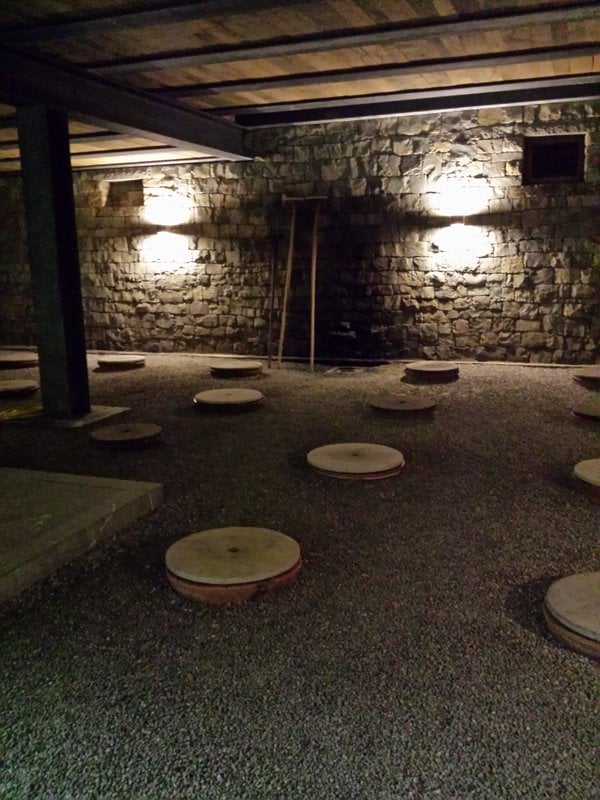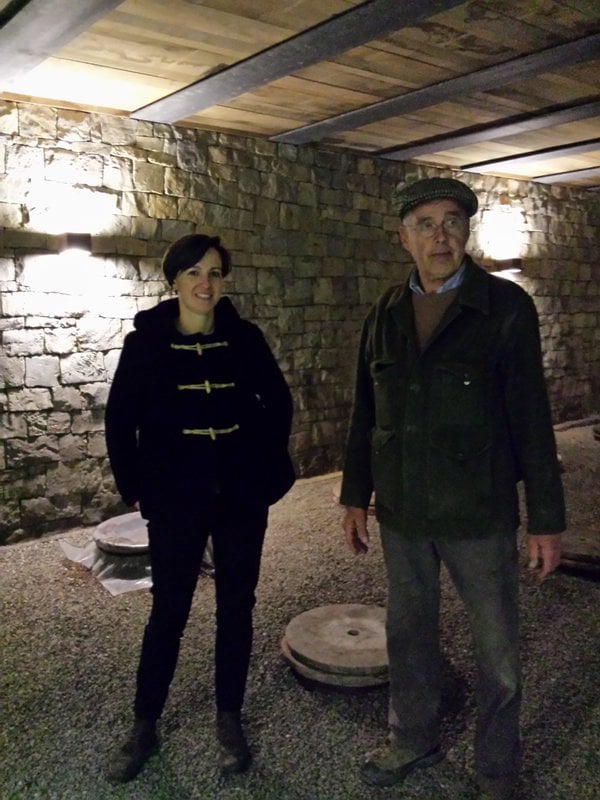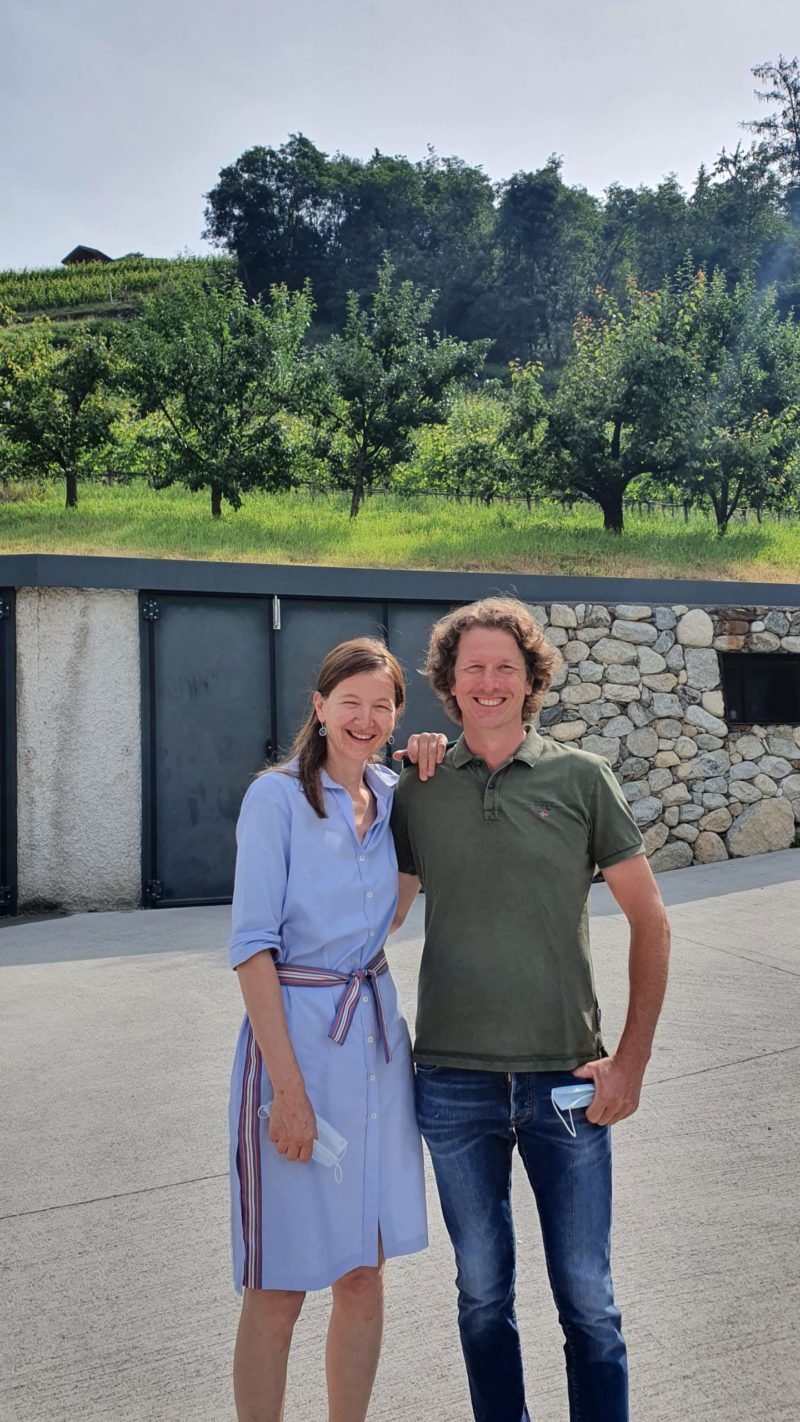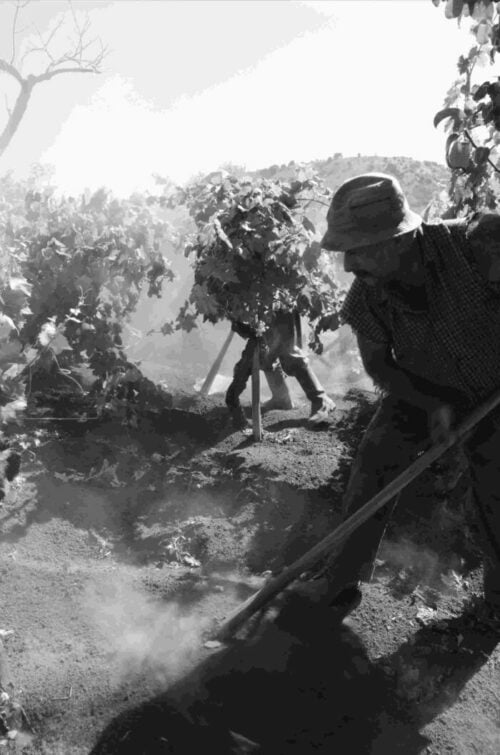Searching for the best way to make pure, terroir-driven wines, a few brave producers in Italy have traded in their temperature-controlled stainless steel fermenting tanks and wooden vats for clay amphorae. For thousands of years, terracotta containers – called by various names in Italian including anfore, orci and giare – were the only option available to early winemakers when they transformed grape juice into wine. Originating in the Caucasus in Georgia – the area credited as the birthplace of wine some 6,000 years ago – these large ceramic jars are still used in the region today.

© Paolo Tenti | Gravner cellar
Due to politics (it was part of the Soviet Union until 1991) and years of civil unrest, Georgia’s amphora wines remained virtually unknown to the rest of the world until the turn of the new century, when Italian winemaker Josko Gravner visited the area and brought some of clay vessels, known as qvevri back to Italy.

© Paolo Tenti | Mateja and Josko Gravner
Today a small but growing number of producers from Italy and around the world have adopted amphorae of varying sizes and origins. For most converts, amphorae are the natural progression of a holistic approach to winemaking that includes eschewing harsh chemicals in the vineyards and a non-interventionist approach in the cellars. Winemakers who have switched to amphorae say the vessels allow them to produce the purest expression of their grapes and vineyard areas.
From beguiling honeyed whites to earthy reds boasting radiant fruit purity, you’ll never forget a wine vinified in amphorae.
Gravner | Pottery Pioneer
Before he switched to amphorae, Josko Gravner had turned in his traditional casks for stainless steel. Gravner, whose vineyards lie in the heart of Friuli’s Collio zone in northeast Italy and stretch into Slovenia, later settled on barriques, believing these were essential for quality wine.
His rich, fragrant wines received critical acclaim, but still, he wasn’t satisfied. He went to California in 1987 for inspiration, but came back disillusioned.
“I came home and told my wife that I was sick of conventional wines, which were going in the opposite direction of safeguarding the soil and authenticity,” says Gravner.
After studying the history of wine, he decided to go to Georgia, in the Caucasus region, where winemaking began.
Because of the country’s instability, Gravner waited until 2000 to make his way to the Caucasus. His first sip of wine there, ladled out of an interred amphora, changed his life.
“Amphorae amplify the good and bad in wine, so it’s essential to have perfect grapes.”
He returned home energized. Gravner imported several of the large amphorae (1,300–2,400 liters) to his winery in the hamlet of Oslavia. Following his new role models, he lined them with beeswax and buried them.
In 2001, he made his first wines in clay: Bianco Breg (a blend of Chardonnay, Sauvignon, Pinot Grigio and Riesling Italico) and Ribolla Gialla, from the native grape of the same name. The first amphora wines were fermented with no selected yeasts, and stayed in contact with the grape skins for another six months, followed by three years of aging in large oak casks.
The amber-colored wines created a sensation when they were released. While some people were put off by their color and austere minerality, others were intrigued by their unfettered purity, dried apricot and honeyed sensations.
“Amphorae act like loudspeakers…” says Gravner. “They amplify the good and the bad in wine, so it’s essential to have perfect grapes.”
Gravner embraces biodynamic viticulture and uses no additives or technology in his cellars, not even temperature control. Starting from the 2007 vintage, his wines age seven years before being bottled. He’s phasing out international grapes to focus on Ribolla Gialla.
COS | Southern Ceramicists
About the same time that Gravner was on his pilgrimage to Georgia, Giambattista Cilia and Giusto Occhipinti of the COS winery in the Ragusa province of southeastern Sicily, were also researching amphorae.
Founded in 1980, COS is credited with reviving Cerasuolo di Vittoria, a local traditional wine. For the first few years, the firm used recycled barrels, but by the late 1980s, influenced by California’s Napa Valley, it was buying new barriques.
“Then we took a huge step back,” says Occhipinti. “In the mid-1990s, we tried some of our earliest bottlings—those matured in recycled barrels—and we were shocked at the difference. With their mineral notes and earthy sensations, the wines were so much more interesting than later vintages matured in new oak that had sensations of vanilla and toast.”
“They let the wines breathe, like wood does, but they don’t impart any wood aromas or flavors.”
The winemakers began experimenting with barrels of different sizes and ages, concrete tanks and amphorae. The clay vessels from Georgia were too big for their needs, and because they sought amphorae that didn’t need to be lined with beeswax or other substances, they tried out amphorae from Sicily, Tunisia and Spain in 2000.
“The 400-liter jars from Spain proved the best for vinification, partly because of the clay, but also for the pure quality of the water used to make dough,” says Occhipinti. “They let the wines breathe, like wood does, but they don’t impart any wood aromas or flavors.”
COS’s first amphora-produced wine was the 2002 Pithos Rosso. A blend of Frappato and Nero d’Avola, this stunning, soulful red quickly became a cult favorite for its succulent berry, floral, mineral and earthy sensations, bright acidity and silky tannins.
In 2008, COS added Pithos Bianco, made from Grecanico. Both wines ferment in unlined amphorae, where they stay in contact with the skins until mid-April, followed by bottling.
COS follows the principles of biodynamic viticulture and has a hands-off approach to winemaking, which includes spontaneous fermentation with wild yeasts. Beside its amphora-aged Pithos wines, the firm’s other offerings ferment in cement. Some reds are aged briefly in large Slavonian casks for added complexity.
Foradori | Return to Tradition
In 1984, as a 20-year-old fresh out of oenology school, Elisabetta Foradori took over the family winery, located in Trentino’s Dolomites mountain range. She wasn’t content with the technically perfect wines resulting from commercial clones and mechanized vineyard practices. So, in 1985, she began a massal selection of her estate’s Teroldego grapes, eventually registering 15 clones that she later replanted in one of her largest vineyards.
While quality improved, Foradari still wasn’t satisfied. Something was missing.
“The wines I produced back then lacked soul,” she says.
In 2002, she started to convert to biodynamic viticulture. The winery earned its Demeter certification in 2009.
“Biodynamic isn’t just a certificate, it’s part of a way of life that’s about respecting nature,” says Foradori. In 2009, she sought just the right fermentation vessel for her native white grape, Nosiola
“Years ago, winemakers used to macerate Nosiola on the skins, and the wines had complexity and character, nothing like the lightweight wines made from the grape today,” says Foradori.
“Wines vinified in amphorae give the purest expression of the grape and terroir.”
Giusto Occhipinti from COS suggested amphorae from Spain: “I was intrigued, because amphorae are made with four symbolic elements: earth, fire, water and light,” she says. “I tried them out, and found what I was looking for. They completed the process I started in the vineyards 15 years ago.
“Wines vinified in amphorae give the purest expression of the grape and terroir.”
She warns, however, that working with the clay vessels isn’t always easy.
“They’re full of surprises,” says Foradori. “Wines vinified in amphorae are more alive, and because of this, they are always changing. They have good days and bad days.”
Fermented and aged for eight months on the skins in unlined amphorae, Foradori’s fragrant and elegantly structured Fontanasanta Nosiola has good midterm aging potential. Her two single-vineyard Teroldegos both show juicy fruit and earthy sensations, but reveal distinct personalities. All the wines benefit from long aeration before pouring.
Fontodi | Molding Tuscan Clay
Founded in 1968 in the heart of Chianti Classico, Fontodi makes highly acclaimed wines from Tuscany, including its Chianti Classico Gran Selezione Vigna del Sorbo (formerly a Riserva) and IGT Toscana Flaccianello della Pieve.
The estate’s production is certified organic, and wines are fermented with wild yeasts. Its 100-percent Sangiovese, vinified and aged in amphorae and released in late 2014, intrigued the Italian wine world.
“Gravner was a pioneer and definitely an inspiration,” says Giovanni Manetti, who runs the family-owned winery.
His brother, Marco, manages the other family business, a ceramics firm specializing in terra cotta flooring and tiles. Its products have helped restore key Tuscan landmarks, including Brunelleschi’s dome in Florence.
With Marco’s collaboration, Giovanni decided to try fermenting in amphorae.
“My family has eight generations of experience with terra cotta, so we decided to use our own amphorae instead of buying,” says Giovanni.
The firm has long made amphorae—called orci in Tuscany—for gardens and olive oil, but stopped making them for vinification in 1930. In 2008, they restarted production of 400- and 550-liter vinification vessles. Each takes a month to complete.
“But the best part is that the clay for our amphorae comes from the same land where our grapes are grown, bringing the production full circle.”
“At first, wine leaked out of the pores, but we didn’t want to line them internally,” says Giovanni. “We combed through company documents and found the missing step—we had to wipe down the clay with a wet sponge just before the drying process.
“This reduced the size of the pores. The wine breathes, but doesn’t pass through.”
The orci are fitted with custom stainless-steel closures that never have contact with the wine.
“But the best part is that the clay for our amphorae comes from the same land where our grapes are grown, bringing the production full circle,” says Giovanni.
Fontodi’s first release was the 2012 Dino, named in honor of the Manettis’ father. The wine is fermented and left on the skins in amphorae for nine months, then racked and aged another six months in the clay jars. No sulfites are added. Dino offers a pristine version of Sangiovese, delivering freshness, bright fruit, balance and finesse.
St. Pauls | Ancient Vines, Ancient Tech
St. Pauls in Alto Adige is one of the oldest but most dynamic cooperative cellars in the region with a longtime focus on quality wines. Named after the local parish church, the winery was created in 1907 and has 200 members that supply grapes from approximately 425 acres of vineyards.
The steep hillsides naturally limit grape yields. The growing areas, protected by the Alps and which benefit from 1,800 hours of annual sunlight, enjoy warm days and cool nights during the ripening period, which allows for ideal grape maturation. Over the years, St. Pauls’ growers have embraced sustainable farming methods, and the winery has adopted environmentally friendly cellar practices.
Alto Adige is best known for its vibrant, aromatic whites, including Sauvignon Blanc, Gewürztraminer, Pinot Grigio and Pinot Bianco. And though Pinot Bianco has been abandoned in much of the Old World and never took off in the New World, it remains a focus for Alto Adige growers, where it boasts delicate apple sensations and lively acidity.
“We have what’s considered the oldest Pinot Bianco vineyard in Alto Adige, planted in 1899.”
In addition to the winery’s Pinot Bianco, vinified in stainless steel, and its barrel-fermented and -aged Passion Riserva, St. Pauls recently introduced its newest Pinot Bianco, Sanctissimus Riserva—fermented and aged entirely in clay vessels.
“We have what’s considered the oldest Pinot Bianco vineyard in Alto Adige, planted in 1899,” says Alessandro Righi, St. Pauls’ managing director. “We wanted to combine the old age of the vines with the origins of winemaking by using amphorae.”
In 2009, the winery began to experiment with amphorae made by TAVA Ceramiche in Trento. After years of trials, it decided on custom-made, unlined, 300-liter jars made using clays from Tuscany, Lazio and Veneto. In mid-2016, the cooperative released its 2013 Sanctissimus.
“The clay jars allow for a long, slow fermentation, which creates more complexity and a tannic structure that is more similar to a red,” says Wolfgang Tratter, the firm’s winemaker.
Fermented spontaneously in amphorae with wild yeasts and aged in clay for one year, Sanctissimus has an energized mineral vein and shows good aging potential.
Amphora COS Fontodi Foradori Italian wine Josko Gravner St. Pauls
Last modified: December 31, 2023




